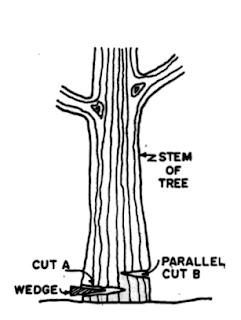Search This Blog
Most Popular
Categories
- Building Construction (86)
- Building Materials (83)
- Columns (2)
- Concrete Beam (3)
- Concrete Construction Techniques (4)
- Concrete Mix Design (13)
- Concrete Repair (14)
- Concrete Slab (10)
- Construction Equipment (16)
- Construction News (7)
- Design of Structures (15)
- Engineering Drawing (1)
- Estimation (3)
- Geotechnical engineering (26)
- Highway Engineering (11)
- Innovations (32)
- Material Testing (10)
- Matrix Analysis of Structures (2)
- Mechanical Engineering (3)
- Strength of Materials (2)
- Structural Analysis (13)
- Structural Design (22)
- Structures (17)
- Transportation Engineering (9)
Felling of Trees | Processing of Timber
Neenu
April 16, 2024
Timber undergoes various processing and treatment before it is finally used for building construction applications. Processing of timber from start to end involves 4 major processes, namely Felling of Trees, Seasoning of Timber, Conversion of Timber and Preservation of Timber.
Trees for timber should only be felled after it has fully matured but before the heartwood starts deteriorating. The age of tree felling varies between 50 to 100 years according to its type and local conditions.
To be more specific, based on season and region, felling of trees is performed in
This article discusses in detail the felling of timber trees, the considerations and methods followed in detail.
Felling of Timber Trees
The process of cutting a standing tree is known as felling. The felling of a tree is performed under the following considerations:- Age of the tree for felling
- Time or Season for felling
- Method of felling
1. Age of the Tree for Felling
If the tree is not felled after the maturity period, the heartwood starts to deteriorate. On the other hand, early felling of the tree will have high sap that indicates it hasn’t reached its full strength. Hence,Trees for timber should only be felled after it has fully matured but before the heartwood starts deteriorating. The age of tree felling varies between 50 to 100 years according to its type and local conditions.
2. Time or Season of Felling
Based on season, trees are felled when the sap is at rest. Felling trees during sap at motion affects the seasoning process of timber.- As the sap is in motion during the autumn and spring seasons, felling is not performed during these seasons.
- On the other hand, felling is performed during winter and early summer. During these seasons, sap and moisture content is at low percentages and the cambium layer is inactive and the growth of the tree is dull.
- In the Hilly region during mid-summer (As heavy rainfall in winter)
- In plain regions, it is performed in mid-winter (As wood is not subjected to splitting and growth of fungus during direct sun rays).
3. Method of Felling
When felling a standing tree for timber, special methods are followed to yield more timber. For instance, if the tree is cut at a place below the ground level but higher up the roots, more timber can be yielded. So, to avoid wastage of obtainable timber, a team of experienced persons should be employed in the felling of trees. |
| Fig.1. Method of Felling of Trees |
Rules and Techniques for Tree Felling
- Assess the direction of the felling before proceeding.
- Begin by making a cut at the lowest feasible point on the trunk, extending it beyond the center of gravity of the tree's cross-section, depicted as location A in Figure 2. Ensure this cut is made on the opposite side of the intended falling direction.
- Create a parallel cut, labeled B, above the initial one, but in the opposite direction.
- Securely fasten ropes around the tree's top on all four diametrically opposite sides.
- Gradually apply tension to the rope on the intended falling side while loosening the rope on the opposite side.
- Through controlled swinging motions, induce the trunk to break at the level of cuts, allowing the tree to fall gently to the ground to prevent damage.
- Post-felling, remove branches, and section the log to the required sizes. Promptly remove bark and transport the log for sawing to prevent fungal infestation.
Enhancing Sapwood Quality
Improving the strength and durability of sapwood can be achieved through two methods:- Method I: Enhance sapwood quality by carefully stripping the bark from the entire trunk during the preceding spring season, ensuring the sapwood remains intact.
- Method II: Alternatively, improve sapwood quality by girdling the tree before felling. Girdling involves making a complete axe cut through the sapwood and allowing it to stand until dead. Method I is preferred over Method II for better results.
Read More On: Structure of Timber
Most Visited
Sieve Analysis of Aggregates - ASTM Standard
August 11, 2021
How to Choose Good Quality Aggregates for Construction?
August 10, 2021
What are Infiltration Wells?
April 15, 2024
What is a Cap Beam?
May 15, 2025
Wall Ties or Brick Ties in Construction
June 13, 2022
Top 7 Waterproofing Materials for Concrete Roofs
December 13, 2024
Construction ERP System – A Comprehensive Guide
December 12, 2024
Boring Methods for Soil Exploration
November 02, 2023
The Future of Construction: Leveraging AI and Machine Learning
December 12, 2024
Search This Blog
MUST READ
What is PERT? Objectives, Pros & Cons
September 10, 2017
Terzaghi's Equation: Soil Bearing Capacity for Foundations
March 02, 2022
Contact Form
Footer Menu Widget
Created By SoraTemplates | Distributed By Gooyaabi Templates

0 Comments
Commenting Spam Links Are Against Policies